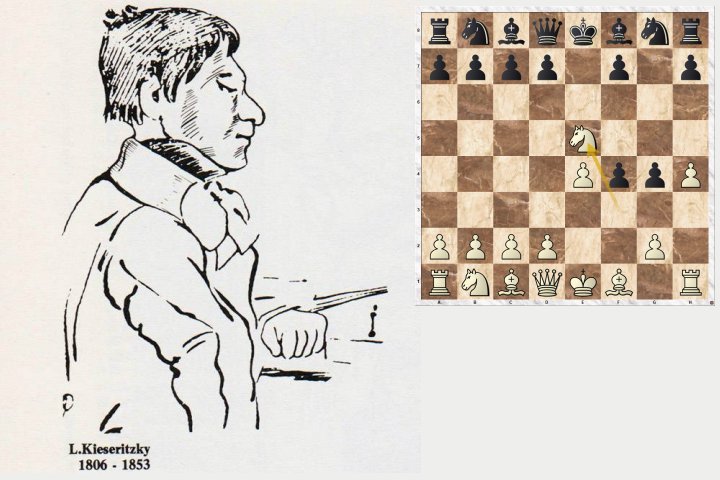Kieseritzky's Immortal Game
by Stephan Oliver Platz
Recently Dagobert Kohlmeyer published an interesting article on ChessBase dealing with the famous "Immortal Game" which was played 170 years ago by Adolph Anderssen and Lionel Kieseritzky. He rightly pointed out that winners are always admired while people are less interested in the losers. But this need not go on forever. This is why I took a closer look at Kieseritzky's games and actually discovered some real gems among them. In this article I'll try to find some answers to the following questions: How did Lionel Kieseritzky play chess and what is his legacy for the world of chess?
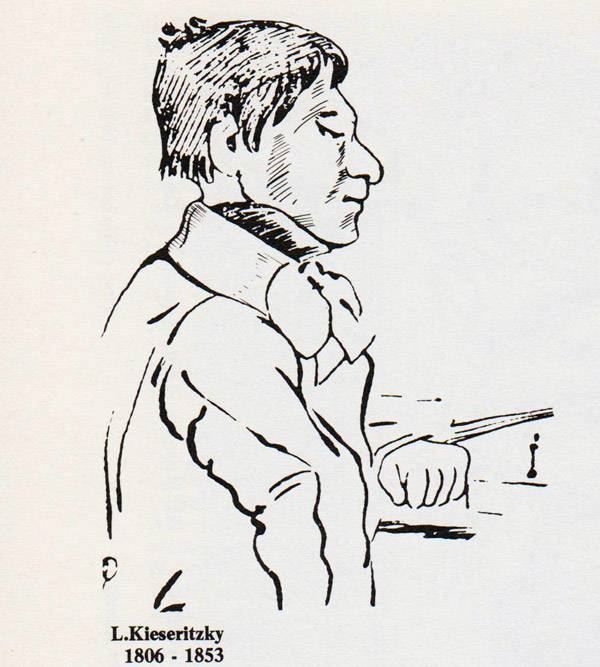
A mathematics teacher becomes the main attraction of the Café de la Régence
Lionel Kieseritzky was born on January 1, 1806 in Dorpat (Livonia, now part of Estonia) and died on May 18, 1853 in Paris. He was of German-Baltic origin and thus belonged to the German-speaking minority living in Estonia and Latvia. Dorpat, which is now called Tartu, was then part of the Russian Empire and had a German-speaking university, where Kieseritzky studied philology and law from 1825 to 1829. He left the university without a degree and worked as a mathematics teacher. Kieseritzky supposedly learned chess as a child from his father and his brother Felix. Unfortunately, no games have been preserved from his early period.
In 1839, Kieseritzky moved to Paris. This brought momentum, but also a great deal of insecurity into his life. In the 8th edition of the German "Handbook" by von Bilguer and von der Lasa, the chess historian O. Koch dealt with Kieseritzky: "He left Livonia because the domestic conditions became unpleasant for him, came to Paris in 1839 to make a living as a teacher of mathematics and chess, and soon became the main attraction of the Café de la Régence". (a)
At that time, this café was, next to London's "Simpson's-in-the-Strand", the most exclusive meeting place for European chess players. From the fact that the newcomer Kieseritzky quickly became the main attraction of the Café de la Régence, we can conclude that he must have either been particularly strong by the standards of the time or at least played very attractive chess for the public. We will see this clearly later on the basis of some of his games.
A "brilliant master" and "excellent theoretician"
In his text-book, Jean Dufresne characterized Kieseritzky as a "brilliant master" and "excellent theoretician" who lived in Paris and was one of the participants in the London tournament of 1851. He also mentioned the important variation of the King's Gambit which is named after him ("Kieseritzky Gambit"). Obviously, Kieseritzky had a good reputation. (b)
A look into the Mega Database
The Mega Database is an indispensable tool for all those interested in chess history. By entering the search term "Kieseritzky" you'll find 92 games played by him within a few seconds. In 43 cases he had the white pieces and won 26 times with 13 losses and 4 draws. He was almost as successful with the black pieces, winning 27 of a total of 49 games and losing only 16, while 6 ended in a draw. Since by no means all the games played by Kieseritzky were recorded and published, such figures must of course be interpreted with the necessary caution. Nevertheless, the games at hand give a good insight into the way Kieseritzky played chess. Later on we'll take a look at some remarkable examples.
Which openings did Kieseritzky prefer?
This question can also be answered easily by using the Mega Database. You only have to search for "Kieseritzky", then open the Mega Database and go to "Players", select "Kieseritzky,Lionel", right-click with the mouse and select "Prepare against White" and "Prepare against Black". Now you have all the information you need and can easily check the player's opening repertoire. (By the way, you can do all this with the Big Database, too. It contains the same games, only without annotations.)
The ChessBase Mega Database 2021 is the premiere chess database with over 8.4 million games from 1560 to 2020 in high quality.
In Kieseritzky's case we learn that he preferred the move 1 e4 which his opponents usually answered with 1 ... e5. The King's Gambit 2 f4 was his favourite opening. After 2 ... exf4 he always continued with 3 Nf3. The Bishop's Opening 2 Bc4 was played by Kieseritzky, too, although only about half as often as the King's Gambit. More rarely we see the Giuoco Piano and the Scotch Gambit. Against the Sicilian Defence 1 e4 c5 Kieseritzky played either 2 b3 and 3 Bb2 or 2 Bc4 and 3 Nc3. An open Sicilian with 2 Nf3 and 3 d4 soon turned into a variation of the Smith-Morra Gambit, since Kieseritzky did not retake after cxd4, but sacrificed the pawn by playing Bc4 and c3. Against the French Defence 1 e4 e6 Kieseritzky usually played the exchange variation 2 d4 d5 3 exd5 exd5 and now 4 c4 producing a position similar to the Queen's Gambit. The Queen's Gambit 1 d4 d5 2 c4 was also played by Kieseritzky, but considerably less often than 1 e4, whereby in the Queen's Gambit Declined 2 ... e6 3 Nc3 Nf6 he always continued with 4 Bf4 instead of 4 Bg5.
When Kieseritzky had the Black pieces, the opening was almost exclusively 1 e4 which he regularly answered with 1 ... e5. In only two games he played the Sicilian Defence 1 ... c5. After 1 e4 e5 2 Nf3 Nc6 3 Bc4 Kieseritzky almost always answered with 3 ... Bc5 leading to the usual variations of the Giuoco Piano (4 c3 Nf6). Against the Evans Gambit 4 b4 Bxb4 5 c3 he preferred 5 ... Bd6 (instead of the usual 5 ... Ba5 which also occurred in one of his games), a move that strengthens the centre but also blocks the QP and imprisons the QB. We find some other openings, too, e. g. the Scotch Game and the Scotch Gambit (with the hazardous continuation 4 ... Bb4+), the Ruy Lopez (with the classical defence 3 ... Bc5 which Bobby Fischer also played in some of his games) and the Ponziani Opening 2 Nf3 Nc6 3 c3 (with the defence 3 ... Nf6). In the Petrov's Defence 1 e4 e5 2 Nf3 Nf6 it is remarkable that Kieseritzky had the nerve to get involved in the unclear intricacies after the risky 3 Nxe5 Nxe4?! 4 Qe2 Qe7 (a win and a draw proved him right). When Kieseritzky had to deal with the King's Knight Gambit 1 e4 e5 2 f4 exf4 3 Nf3 he played either 3 ... g5 (the classical variation) or 3 ... Be7 (Cunningham Defence). Against the King's Bishop Gambit (3 Bc4) Kieseritzky had a special variation beginning with 3 ... b5!? or 3 ... Qh4+ 4 Kf1 and now 4 ... b5!?, a dubious countergambit which is not even mentioned in MCO 15. Kieseritzky's defence against the Queen's Gambit is curious, too, because after 1 d4 d5 2 c4 dxc4 3 e4 he played 3 ... f5?! resulting in one win and one loss (the only two games beginning with 1 d4). Other first moves are practically irrelevant. In one game we see 1 f4 d5 and in another one 1 g3 e5 2 Bg2 d5.
"The most wayward and crotchety of players"
Why did Kieseritzky play dubious variations and defences in many of his games? The English grandmaster Howard Staunton, who was considered the strongest player in the world from 1843 to 1851, wrote about it in his book "Chess Praxis":
"With all his fine genius and extraordinary knowledge of the game, Kieseritzky was the most wayward and crotchety of players. (...) In
his Openings he delighted in all sorts of odd, out-of-the-way manoeuvring. In his End-games, when the road to victory lay plain
and direct before him, he would turn aside, as if from sheer wantonness (...) These eccentricities have been set down to an obliquity of mind. I am disposed to attribute them in part, at least, to another cause. He entertained a great repugnance to giving odds, and as his opponents were, for the most part, immeasurably inferior to him both in skill and bookish lore, he could of course afford, when playing "even" with them, to risk a good deal. Of what import was the loss of a few moves or of two or three Pawns to one who felt he was a Rook stronger than his adversary? It was thus probably that he acquired that fondness for rash attacks, and whimsical defences, which injured his game and told against him so terribly when he came to cope with men of mettle like his own." (c)
Staunton's assessment might not apply to all of Kieseritzky's preferred variations, because some of those that seemed bizarre to the chess masters then are commonplace today. For example, Kieseritzky's 5 ... Bd6 in the Evans Gambit made it into the Encyclopaedia of Chess Openings ("C51"), as did his 2 b3 against the Sicilian ("B20"). In these two cases he was probably rather ahead of his time. (By the way: Aaron Nimzovich was also accused of playing the opening whimsically or incorrectly. What do people think about it today?) Regarding Kieseritzky's style of play, Staunton is most probably right. But it is precisely this way of playing chess that leads to many exciting and thrilling games, such as the following.
Kieseritzky's Immortal Game
Playing over Kieseritzky's games, I noticed many amazing moves and astonishing sacrifices. He certainly was a typical representative of the romantic era of chess. Let's for instance take a look at a game Kieseritzky played in Paris on January 5, 1846, against Conrad Vitzthum von Eckstaedt. I call it "Kieseritzky's Immortal Game".
This game was published in the book "Cinquante Parties jouées au Cercle des Échecs et au Café de la Régence" (Fifty games played at the Cercle des Échecs and the Café de la Régence) edited by Kieseritzky in 1846. (d)
Kieseritzky defeats Horwitz and Harrwitz
In 1846 Kieseritzky won a match against Bernhard Horwitz (1807 - 1885) with 7-4 =1. The fact that out of 12 match games only one ended in a draw shows how uncompromisingly they fought at that time. Horwitz came from Germany and, before moving to London, was a leading member of the Berlin Chess Society and one of the seven "Pleiades", a group of chess masters that also included Ludwig Bledow, Paul Rudolph von Bilguer, Tassilo von Heydebrand und der Lasa, Karl Mayet, Wilhelm Hanstein and Karl Schorn.
In 1847 Kieseritzky played a match against the chess master Daniel Harrwitz (1823 - 1884) from Breslau (now Wrocław), who later lived in London, Paris and Bolzano, and won with 11-5 =2. Here, too, only two games were drawn, a result that would be almost unthinkable among today's top players. Harrwitz was a really strong player who achieved a 5-5 against Adolph Anderssen in 1848 and won three games against Paul Morphy in 1858 (with five losses and one draw).
Unlucky in London 1851
In 1851 the World's fair took place in London and the English grandmaster Howard Staunton came up with the idea of organizing an international chess tournament on this occasion. Kieseritzky, as France's leading player, was also invited. Unfortunately, unfavourable tournament rules excluded him after only three games.
The tournament had a total of 16 participants and was played in a knockout system. Two wins in the first round were enough to advance while draws did not count. Misfortunately Kieseritzky had to play against the eventual tournament winner Adolph Anderssen from Germany. Kieseritzky quickly lost the first game. After some serious blunders he was mated on move 20. In the second game he played better and in the endgame he could have won twice by making obvious moves, but he missed the chance and the game ended in a draw after 55 moves. In the third game a careless pawn move (12 f4?) caused Kieseritzky trouble.
After some other terrible mistakes he lost a piece and the game. It lasted only 17 moves. When you look at these three games against Anderssen, you realize that Kieseritzky was completely indisposed in the London tournament. In this form he would not have had a chance against any other opponent.
Many casual games and Anderssen's "Immortal Game"
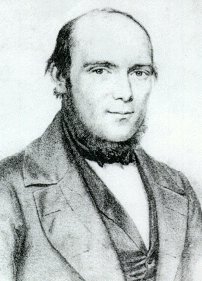
Apparently Kieseritzky used his stay in London to play several casual games against the other chess masters. I found a compilation on the internet according to which he was victorious against Henry Thomas Buckle, Karl Mayet, Josef Szén, Johann Jakob Loewenthal, Henry Edward Bird and even Adolph Anderssen. (e) To what extent all this is true and whether the figures are trustworthy is not so easy to determine and would in any case require a very time-consuming verification. Have all the casual games played really been taken into account? Or are the results only based on the games that have become known, i.e. those published in books and chess magazines? Perhaps a ChessBase reader has reliable information on this. In this case I would be grateful for a corresponding message with references.
During one of these encounters Adolph Anderssen played his "Immortal Game". After sacrificing all his pieces except for two knights and a bishop, he spectacularly mated Kieseritzky on move 23 while his opponent still had all his major and minor pieces.
Kieseritzky's favourite defence against the King's Bishop Gambit
This brings us to one of Kieseritzky's favourite variations which may seem strange to us now, but was taken quite seriously then. Kieseritzky regularly defended the King's Bishop Gambit 1 e4 e5 2 f4 exf4 3 Bc4 with an early b5!?. In the following game he was successful with it. Once again we see romantic Wild West in its purest form.
Perhaps Kieseritzky's countergambit is not so bad after all. A few years later both Adolph Anderssen and the great Paul Morphy tried it with the black pieces, too, Morphy even in three of his games.
The Kieseritzky Gambit
This is the name of a variation of the King's Gambit which was recommended by Kieseritzky:
1 e4 e5 2 f4 exf4 3 Nf3 g5 4 h4 g4 5 Ne5
This move is safer than 5 Ng5 ("Allgaier Gambit"), because after 5 ... h6 White is forced to sacrifice his Knight.
In the next game Black answered Kieseritzky's 5 Ne5 with 5 ... h5, a defence that was very popular in the middle of the 19th century. Soon the Queens are exchanged, but Black subsequently fails to bring his QR into play (24 ... Kb7!) giving Kieseritzky the opportunity to win by 26 Nxc5! The race of the passed Pawns ends in his favour and after 35 moves the unfortunate black Rook is lost (35 ... Kb7 36 Na5+).
Kieseritzky's opponent was John William Schulten (1821 - 1875), a German-American chess player about whom little is known. In the Mega Database I found 47 of his games, mostly defeats against strong contemporary chess masters, including Pierre de Saint-Amant, Bernhard Horwitz, Lionel Kieseritzky, Daniel Harrwitz, Gustav Richard Neumann, Ignaz Kolisch, Adolph Anderssen and Paul Morphy. In New York in November 1857 Schulten played 24 casual games against the American World Champion and lost 23 of them. But at least he showed stamina and even won a game against Morphy in only 18 moves. (f)
This DVD concentrates on the King's Gambit accepted with 3.Bc4. Williams has included a lot of novelties and interesting attacking variations that should wet the lips of any attacking player, looking for an interesting way of meeting 1...e5!
Some of the most interesting lines in the King’s Gambit starting with 3 Nf3, especially concentrating ‘on the refutation of the King’s Gambit (Fischer)’ 3...g5. And what happens if Black does not play 2...exf4 is covered.
Boris Spassky and Bobby Fischer in Kieseritzky's footsteps
Of course, the King's Gambit is no longer as important today as it was in the past. This is evident from the fact that, for example, the eighth edition of the German "Handbook", revised by grandmaster Carl Schlechter in 1916, devoted 131 of 752 pages to the King's Gambit (17.4%), while the latest edition of "Modern Chess Openings" (MCO 15) from 2008 used only 15 of 739 pages (2%) for it. Nevertheless, the variation of the King's Gambit named after Kieseritzky has been played time and again by strong grandmasters in recent decades, including Nigel Short, Alexei Fedorov, John Nunn and Boris Spassky, the World Champion from 1969 to 1972. In one of his games against Bobby Fischer he played the Kieseritzky Gambit and won after an exciting struggle. Fischer made the decisive mistake on move 26 (26 ... Rf8?), after which Spassky got a winning position.
This defeat induced Bobby Fischer to recommend the more cautious 3 ... d6 after 1 e4 e5 2 f4 exf4 avoiding the dangerous Kieseritzky Gambit. After 4 d4 g5 5 h4 g4 the white Knight can no longer go to e5 because a black Pawn is already on d6.
No other World Champion was more infamous both inside and outside the chess world than Bobby Fischer. On this DVD, a team of experts shows you the winning techniques and strategies employed by the 11th World Champion.
Grandmaster Dorian Rogozenco delves into Fischer’s openings, and retraces the development of his repertoire. What variations did Fischer play, and what sources did he use to arm himself against the best Soviet players? Mihail Marin explains Fischer’s particular style and his special strategic talent in annotated games against Spassky, Taimanov and other greats. Karsten Müller is not just a leading international endgame expert, but also a true Fischer connoisseur.
Kieseritzky's legacy
What is Kieseritzky's legacy for the world of chess? First of all there are his thrilling games. Many of them can be found in the Mega Database, including his famous loss against Adolph Anderssen, extensively annotated by grandmaster Robert Huebner. Both this game and the "Kieseritzky Gambit" as an important variation of the King's Gambit will certainly ensure that he will never be forgotten.
Those who speak French may download digitized copies of Kieseritzky's book "Cinquante Parties jouées au Cercle des Échecs et au Café de la Régence" and of an edition of the chess magazine "La Régence" which was edited by Kieseritzky from 1849 to 1851. (g)
When replaying the games in these publications, however, there are some difficulties to overcome. O. Koch: "Unfortunately Kieseritzky used a highly cumbersome notation (...) This stubborn procedure prevented his publications from becoming more popular". (a)
The opening moves 1 e4 c5 2 Nf3 Nc6 3 d4 cxd4 would look like this in Kieseritzky's "lexicographic notation": 1.e45 c53 2.G36 B63 3.d44 c44-d.
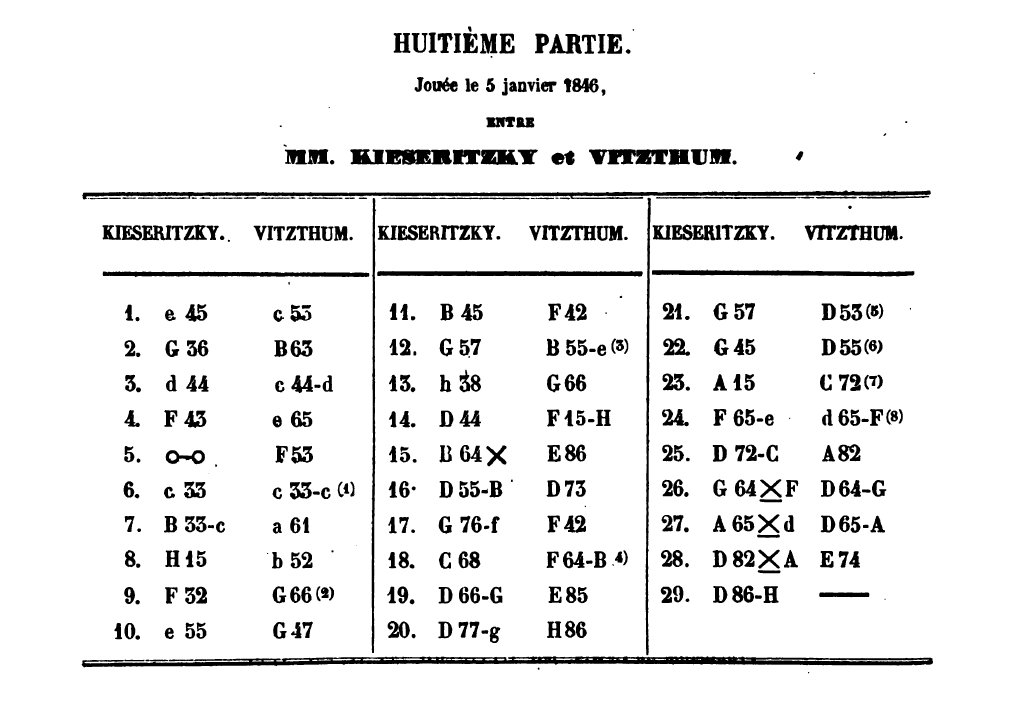
References:
- (a) O. Koch, "Das Schachspiel der neuen und neuesten Zeit" (The game of chess in the new and newest times), published in "Handbuch des Schachspiels" (Handbook of Chess) by Paul Rudolph von Bilguer and Tassilo von Heydebrand und der Lasa, eighth edition, revised by Carl Schlechter, Berlin and Leipzig 1916, p. 102.
- (b) Jean Dufresne, "Lehrbuch des Schachspiels", 7th edition, Leipzig 1901, p. 531
- (c) Howard Staunton, „Chess Praxis“, London 1860, p. 175
- (d) L. Kieseritzky, „Cinquante Parties jouées au Cercle des Échecs et au Café de la Régence“, Paris 1846, p. 8
- (e) http://dts-web1.it.vanderbilt.edu/~spinrajp//chessmatches.html
- (f) Other sources mention 29 games. This seems less likely to me because of the odd number.
- (g) https://archive.org/details/cinquantepartie00unkngoog https://archive.org/details/bub_gb_UBRBAAAAYAAJ
According to the list of members, 68 chess players belonged to the "Cercle des Échecs" in 1849. Pierre de Saint-Amant and Lionel Kieseritzky were the most prominent ones. There were also 10 honorary members: Calvi, von der Lasa, Jaenisch, Laroche, Lewis, Mongredien, Petrow, Staunton, Szén and Walker. The complete list can be found there: https://www.schach-chess.com/media/deutsch/Schachgeschichte/Schachcafe/membres-cercle-des-echecs-paris-1849.jpg
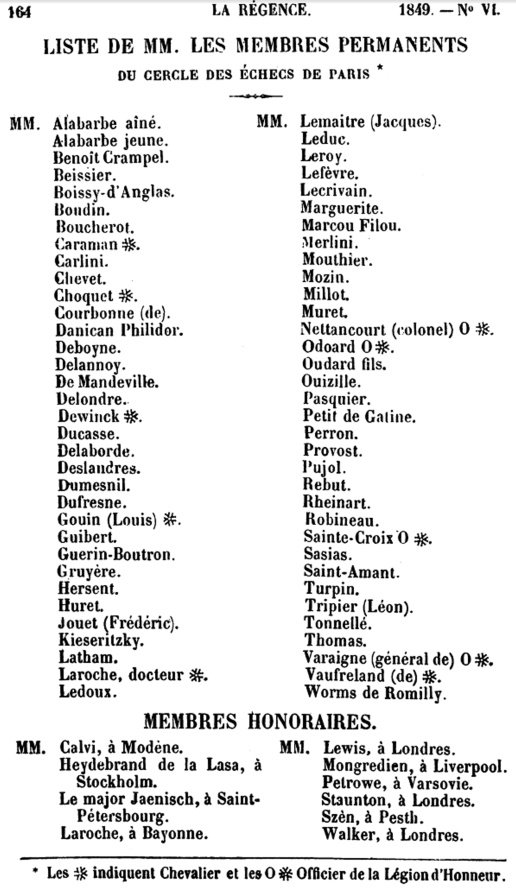
https://www.schach-chess.com/media/deutsch/Schachgeschichte/Schachcafe/membres-cercle-des-echecs-paris-1849.jpg
(g) https://archive.org/details/bub_gb_UBRBAAAAYAAJ
